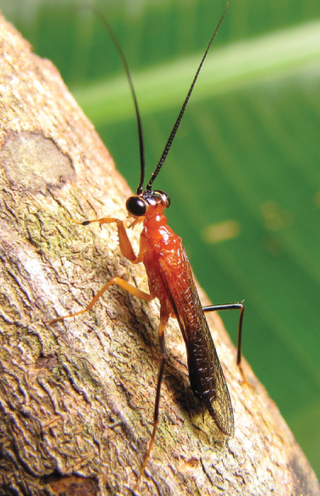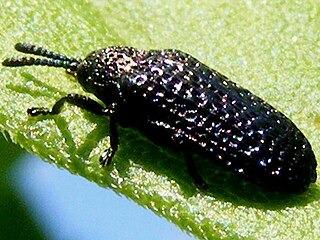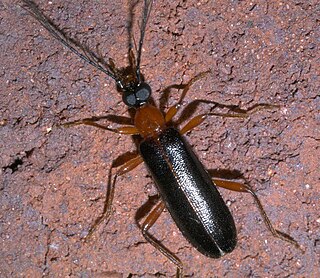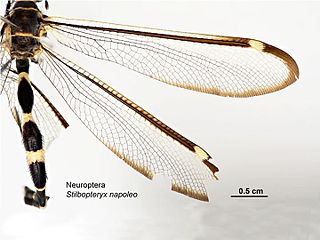
Nucras is a genus of African lacertid lizards, commonly called sandveld lizards.

Elgaria is a genus of New World lizards in the family Anguidae. Their common name is western alligator lizards.

Plethodon is a genus of salamanders in the family Plethodontidae. They are also known as woodland salamanders or, more rarely, slimy salamanders. All members of the genus are endemic to North America. They have no aquatic larval stage. In some species, such as Plethodon cinereus, the red-backed salamander, eggs are laid underneath a stone or log. Young hatch in the adult form. Members of Plethodon primarily eat small invertebrates. The earliest known fossils of this genus are from the Hemphillian of Tennessee in the United States.

The Pneumodermatidae are a family of sea angels, or small floating predatory sea snails or sea slugs. They are pelagic marine heterobranch opisthobranch gastropod mollusks in the clade Gymnosomata.

Mantoida is a genus of praying mantises in the family Mantoididae. The species of this genus are native to Mexico, Central America, and South America.

Moneilema, or cactus longhorn beetles are a genus of large, flightless, black beetles found in North American deserts of the western United States and northern Mexico. M. gigas is native to the Sonoran desert at elevations below 4900 feet (1500m). The front wings of these beetles are fused forming a single, hardened shell, from which the genus derives its Latin name. The genus includes twenty species.

Endomychidae, or handsome fungus beetles, is a family of beetles with representatives found in all biogeographic realms. There are around 120 genera and 1300 species. The family was established based on the type genus Endomychus, a genus erected in 1795 by Panzer which was applied to a species that Linnaeus called Chrysomela coccinea. As the common name suggests, Endomychidae feed on fungi. Crowson, in his influential treatment of the beetles, placed the family within the Cucujoidea. They have a tarsal formal of 4-4-4 or 3-3-3 and the wings lack a closed radial cell. The second antennal segment has a sensory appendage that is as long as the third antennal segment. The family has also been grouped with the Coccinellidae in a group called the Trimera for having pseudotrimerous tarsi. A 2015 molecular phylogeny study found that the Cucujoidea were found to be non-monophyletic and the Endomychidae was refined with the removal of the Anamorphinae from within the family and elevated to the status of a full family, Anamorphidae. Mycetaeinae and Eupsilobiinae were also found not to belong within the clades of the core Endomychidae, and likewise reclassified into the families Mycetaeidae and Eupsilobiidae.

Mantoididae is a family of praying mantises which contains Neotropical species of praying mantises from tropical North and South America. The family was formerly represented by the sole genus Mantoida, until the genus Paramantoida was described in 2014 and Vespamantoida in 2019. The family differs from the closely related Chaeteessidae in having an apical claw on the fore tibiae which are also less curved. Males have ocelli and a cylindrical body shape, unlike the dorsoventrally flattened Chaeteessidae. The cerci are also shorter.

Cyclotrachelus is a genus of beetles in the family Carabidae, containing the following species:

Callidium is a genus of beetles in the family Cerambycidae, containing the following species:

Pteronarcys is a genus of giant stoneflies in the family Pteronarcyidae. There are about 8 described species in Pteronarcys.

Calopteron is a genus of net-winged beetles in the family Lycidae.

Acroneuria is a genus of common stoneflies in the family Perlidae. There are more than 30 described species in Acroneuria.

Microrhopala is a genus of tortoise beetles and hispines in the family Chrysomelidae. There are about 18 described species in Microrhopala.

Dendroides is a genus of fire-colored beetles in the family Pyrochroidae. There are about seven described species in Dendroides.

Helopicus is a genus of springflies in the family Perlodidae. There are at least four described species in Helopicus.

Phylloecus is a genus of sawflies belonging to the family Cephidae.

Hypulus is a genus of beetles belonging to the family Melandryidae. The species of this genus are found in Europe and North America

Drepanacra is a genus of lacewings belonging to the family Hemerobiidae.

Stilbopteryx is a genus of antlions belonging to the family Myrmeleontidae.





















